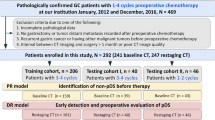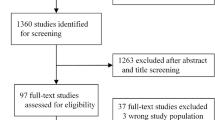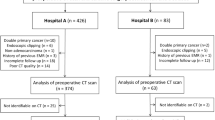Abstract
Effective neoadjuvant chemotherapy (NAC) can improve the survival of patients with locally progressive gastric cancer, but chemotherapeutics do not always exhibit good efficacy in all patients. Therefore, accurate preoperative evaluation of the effect of neoadjuvant therapy and the appropriate selection of surgery time to minimize toxicity and complications while prolonging patient survival are key issues that need to be addressed. This paper reviews the role of three imaging methods, morphological, functional, radiomics, and artificial intelligence (AI)-based imaging, in evaluating NAC pathological reactions for gastric cancer. In addition, the advantages and disadvantages of each method and the future application prospects are discussed.
Graphical abstract





Similar content being viewed by others
References
1 Sung H, Ferlay J, Siegel RL, Laversanne M, Soerjomataram I, Jemal A, Bray F. Global Cancer Statistics 2020: GLOBOCAN Estimates of Incidence and Mortality Worldwide for 36 Cancers in 185 Countries. CA Cancer J Clin. 2021. 71(3): 209-249.
The global, regional, and national burden of stomach cancer in 195 countries, 1990-2017: a systematic analysis for the Global Burden of Disease study 2017. Lancet Gastroenterol Hepatol. 2020. 5(1): 42-54.
3 Sasako M, Sakuramoto S, Katai H, et al. Five-year outcomes of a randomized phase III trial comparing adjuvant chemotherapy with S-1 versus surgery alone in stage II or III gastric cancer. J Clin Oncol. 2011. 29(33): 4387-93.
4 Cunningham D, Allum WH, Stenning SP, et al. Perioperative chemotherapy versus surgery alone for resectable gastroesophageal cancer. N Engl J Med. 2006. 355(1): 11-20.
5 Russell MC. Comparison of neoadjuvant versus a surgery first approach for gastric and esophagogastric cancer. J Surg Oncol. 2016. 114(3): 296-303.
Ajani JA, D'Amico TA, Bentrem DJ, et al. Gastric Cancer, Version 2.2022, NCCN Clinical Practice Guidelines in Oncology. J Natl Compr Canc Netw. 2022. 20(2): 167-192.
7 Smyth EC, Nilsson M, Grabsch HI, et al. Gastric cancer. Lancet. 2020. 396(10251): 635-648.
8 D'Ugo D, Persiani R, Rausei S, et al. Response to neoadjuvant chemotherapy and effects of tumor regression in gastric cancer. Eur J Surg Oncol. 2006. 32(10): 1105-9.
9 Lowy AM, Mansfield PF, Leach SD, Pazdur R, Dumas P, Ajani JA. Response to neoadjuvant chemotherapy best predicts survival after curative resection of gastric cancer. Ann Surg. 1999. 229(3): 303-8.
10 Sylvie L, Susanne B, Katja O. Prediction of response and prognosis by a score including only pretherapeutic parameters in 410 neoadjuvant treated gastric cancer patients. Recent Results Cancer Res. 2012. 196: 269-89.
11 Zurlo IV, Schino M, Strippoli A, et al. Predictive value of NLR, TILs (CD4+/CD8+) and PD-L1 expression for prognosis and response to preoperative chemotherapy in gastric cancer. Cancer Immunol Immunother. 2022. 71(1): 45-55.
12 Jia Y, Ye L, Ji K, et al. Death-associated protein-3, DAP-3, correlates with preoperative chemotherapy effectiveness and prognosis of gastric cancer patients following perioperative chemotherapy and radical gastrectomy. Br J Cancer. 2014. 110(2): 421-9.
13 Kwee RM, Kwee TC. Imaging in local staging of gastric cancer: a systematic review. J Clin Oncol. 2007. 25(15): 2107-16.
14 Kwee RM, Kwee TC. Imaging in assessing lymph node status in gastric cancer. Gastric Cancer. 2009. 12(1): 6-22.
15 Cardoso R, Coburn N, Seevaratnam R, et al. A systematic review and meta-analysis of the utility of EUS for preoperative staging for gastric cancer. Gastric Cancer. 2012. 15 Suppl 1: S19-26.
16 Borggreve AS, Goense L, Brenkman H, et al. Imaging strategies in the management of gastric cancer: current role and future potential of MRI. Br J Radiol. 2019. 92(1097): 20181044.
17 Caivano R, Rabasco P, Lotumolo A, et al. Gastric cancer: The role of diffusion weighted imaging in the preoperative staging. Cancer Invest. 2014. 32(5): 184-90.
18 Yoshikawa T, Tanabe K, Nishikawa K, et al. Accuracy of CT staging of locally advanced gastric cancer after neoadjuvant chemotherapy: cohort evaluation within a randomized phase II study. Ann Surg Oncol. 2014. 21 Suppl 3: S385-9.
Sandø AD, Fougner R, Grønbech JE, Bringeland EA. The value of restaging CT following neoadjuvant chemotherapy for resectable gastric cancer. A population-based study. World J Surg Oncol. 2021. 19(1): 212.
20 Park SR, Lee JS, Kim CG, et al. Endoscopic ultrasound and computed tomography in restaging and predicting prognosis after neoadjuvant chemotherapy in patients with locally advanced gastric cancer. Cancer. 2008. 112(11): 2368-76.
Redondo-Cerezo E, Martínez-Cara JG, Jiménez-Rosales R, et al. Endoscopic ultrasound in gastric cancer staging before and after neoadjuvant chemotherapy. A comparison with PET-CT in a clinical series. United European Gastroenterol J. 2017. 5(5): 641-647.
22 Peng T, Lou Z, Wang X, et al. Clinical Comparison of Endoscopic Ultrasonography and CT in Preoperative TN Staging of Esophagogastric Junction Cancer. Contrast Media Mol Imaging. 2022. 2022: 5810405.
23 Guo T, Yao F, Yang AM, et al. Endoscopic ultrasound in restaging and predicting pathological response for advanced gastric cancer patients after neoadjuvant chemotherapy. Asia Pac J Clin Oncol. 2014. 10(2): e28-32.
Eisenhauer EA, Therasse P, Bogaerts J, et al. New response evaluation criteria in solid tumours: revised RECIST guideline (version 1.1). Eur J Cancer. 2009. 45(2): 228-47.
25 Kurokawa Y, Shibata T, Sasako M, et al. Validity of response assessment criteria in neoadjuvant chemotherapy for gastric cancer (JCOG0507-A). Gastric Cancer. 2014. 17(3): 514-21.
26 Mazzei MA, Bagnacci G, Gentili F, et al. Gastric Cancer Maximum Tumour Diameter Reduction Rate at CT Examination as a Radiological Index for Predicting Histopathological Regression after Neoadjuvant Treatment: A Multicentre GIRCG Study. Gastroenterol Res Pract. 2018. 2018: 1794524.
27 Wang ZL, Li YL, Li XT, Tang L, Li ZY, Sun YS. Role of CT in the prediction of pathological complete response in gastric cancer after neoadjuvant chemotherapy. Abdom Radiol (NY). 2021. 46(7): 3011-3018.
28 Chen C, Dong H, Shou C, et al. The Correlation Between Computed Tomography Volumetry and Prognosis of Advanced Gastric Cancer Treated with Neoadjuvant Chemotherapy. Cancer Manag Res. 2020. 12: 759-768.
29 Lee SM, Kim SH, Lee JM, et al. Usefulness of CT volumetry for primary gastric lesions in predicting pathologic response to neoadjuvant chemotherapy in advanced gastric cancer. Abdom Imaging. 2009. 34(4): 430-40.
30 Beer AJ, Wieder HA, Lordick F, et al. Adenocarcinomas of esophagogastric junction: multi-detector row CT to evaluate early response to neoadjuvant chemotherapy. Radiology. 2006. 239(2): 472-80.
31 Achilli P, De Martini P, Ceresoli M, et al. Tumor response evaluation after neoadjuvant chemotherapy in locally advanced gastric adenocarcinoma: a prospective, multi-center cohort study. J Gastrointest Oncol. 2017. 8(6): 1018-1025.
32 Ang J, Hu L, Huang PT, et al. Contrast-enhanced ultrasonography assessment of gastric cancer response to neoadjuvant chemotherapy. World J Gastroenterol. 2012. 18(47): 7026-32.
33 Satoh A, Shuto K, Okazumi S, et al. Role of perfusion CT in assessing tumor blood flow and malignancy level of gastric cancer. Dig Surg. 2010. 27(4): 253-60.
34 Lundsgaard Hansen M, Fallentin E, Lauridsen C, Law I, et al. Computed tomography (CT) perfusion as an early predictive marker for treatment response to neoadjuvant chemotherapy in gastroesophageal junction cancer and gastric cancer--a prospective study. PLoS One. 2014. 9(5): e97605.
36 Sun ZQ, Yan G, Ge YX, et al. Can low-dose CT perfusion imaging accurately assess response of advanced gastric cancer with neoadjuvant chemotherapy. J Xray Sci Technol. 2017. 25(6): 981-991.
36 Bellomi M, Petralia G, Sonzogni A, Zampino MG, Rocca A. CT perfusion for the monitoring of neoadjuvant chemotherapy and radiation therapy in rectal carcinoma: initial experience. Radiology. 2007. 244(2): 486-93.
37 Djuric-Stefanovic A, Micev M, Stojanovic-Rundic S, Pesko P, Dj S. Absolute CT perfusion parameter values after the neoadjuvant chemoradiotherapy of the squamous cell esophageal carcinoma correlate with the histopathologic tumor regression grade. Eur J Radiol. 2015. 84(12): 2477-84.
38 Becker K, Mueller JD, Schulmacher C, et al. Histomorphology and grading of regression in gastric carcinoma treated with neoadjuvant chemotherapy. Cancer. 2003. 98(7): 1521-30.
39 McCollough CH, Leng S, Yu L, Fletcher JG. Dual- and Multi-Energy CT: Principles, Technical Approaches, and Clinical Applications. Radiology. 2015. 276(3): 637-53.
40 Du W, Yu M, Luo X, Chen M. Application Value of Spectral CT Imaging in Quantitative Analysis of Early Lung Adenocarcinoma. J Oncol. 2022. 2022: 2944473.
41 Zhang Y, Chen J, Yuan F, Zhang B, Ding B, Zhang H. Prognostic role of iodine values for gastric cancer after neoadjuvant chemotherapy: a strong independent prognostic factor. Diagn Interv Radiol. 2022. 28(5): 388-395.
42 Gao X, Zhang Y, Yuan F, et al. Locally advanced gastric cancer: total iodine uptake to predict the response of primary lesion to neoadjuvant chemotherapy. J Cancer Res Clin Oncol. 2018. 144(11): 2207-2218.
43 Tang L, Li ZY, Li ZW, et al. Evaluating the response of gastric carcinomas to neoadjuvant chemotherapy using iodine concentration on spectral CT: a comparison with pathological regression. Clin Radiol. 2015. 70(11): 1198-204.
44 Yang L, Li Y, Shi GF, Zhou T, Tan BB. The Concentration of Iodine in Perigastric Adipose Tissue: A Novel Index for the Assessment of Serosal Invasion in Patients with Gastric Cancer after Neoadjuvant Chemotherapy. Digestion. 2018. 98(2): 87-94.
45 Apfaltrer P, Meyer M, Meier C, et al. Contrast-enhanced dual-energy CT of gastrointestinal stromal tumors: is iodine-related attenuation a potential indicator of tumor response. Invest Radiol. 2012. 47(1): 65-70.
46 Uhrig M, Simons D, Ganten MK, Hassel JC, Schlemmer HP. Histogram analysis of iodine maps from dual energy computed tomography for monitoring targeted therapy of melanoma patients. Future Oncol. 2015. 11(4): 591-606.
47 Heijmen L, Verstappen MC, Ter Voert EE, et al. Tumour response prediction by diffusion-weighted MR imaging: ready for clinical use. Crit Rev Oncol Hematol. 2012. 83(2): 194-207.
48 Feng Y, Liu H, Ding Y, et al. Combined dynamic DCE-MRI and diffusion-weighted imaging to evaluate the effect of neoadjuvant chemotherapy in cervical cancer. Tumori. 2020. 106(2): 155-164.
49 Tong T, Sun Y, Gollub MJ, et al. Dynamic contrast-enhanced MRI: Use in predicting pathological complete response to neoadjuvant chemoradiation in locally advanced rectal cancer. J Magn Reson Imaging. 2015. 42(3): 673-80.
50 Zheng D, Lai G, Chen Y, et al. Integrating dynamic contrast-enhanced magnetic resonance imaging and diffusion kurtosis imaging for neoadjuvant chemotherapy assessment of nasopharyngeal carcinoma. J Magn Reson Imaging. 2018. 48(5): 1208-1216.
51 De Cobelli F, Giganti F, Orsenigo E, et al. Apparent diffusion coefficient modifications in assessing gastro-oesophageal cancer response to neoadjuvant treatment: comparison with tumour regression grade at histology. Eur Radiol. 2013. 23(8): 2165-74.
52 Giganti F, De Cobelli F, Canevari C, et al. Response to chemotherapy in gastric adenocarcinoma with diffusion-weighted MRI and (18) F-FDG-PET/CT: correlation of apparent diffusion coefficient and partial volume corrected standardized uptake value with histological tumor regression grade. J Magn Reson Imaging. 2014. 40(5): 1147-57.
53 Li J, Yan LL, Zhang HK, et al. Dynamic contrast-enhanced and diffusion-weighted MR imaging in early prediction of pathologic response to neoadjuvant chemotherapy in locally advanced gastric cancer. Abdom Radiol (NY). 2022. 47(10): 3394-3405.
54 Zhu Y, Jiang Z, Wang B, et al. Quantitative Dynamic-Enhanced MRI and Intravoxel Incoherent Motion Diffusion-Weighted Imaging for Prediction of the Pathological Response to Neoadjuvant Chemotherapy and the Prognosis in Locally Advanced Gastric Cancer. Front Oncol. 2022. 12: 841460.
55 Le Bihan D, Breton E, Lallemand D, Aubin ML, Vignaud J, Laval-Jeantet M. Separation of diffusion and perfusion in intravoxel incoherent motion MR imaging. Radiology. 1988. 168(2): 497-505.
56 Federau C. Measuring Perfusion: Intravoxel Incoherent Motion MR Imaging. Magn Reson Imaging Clin N Am. 2021. 29(2): 233-242.
57 Fu J, Tang L, Li ZY, et al. Diffusion kurtosis imaging in the prediction of poor responses of locally advanced gastric cancer to neoadjuvant chemotherapy. Eur J Radiol. 2020. 128: 108974.
58 Jensen JH, Helpern JA, Ramani A, Lu H, Kaczynski K. Diffusional kurtosis imaging: the quantification of non-gaussian water diffusion by means of magnetic resonance imaging. Magn Reson Med. 2005. 53(6): 1432-40.
59 Sun K, Chen X, Chai W, et al. Breast Cancer: Diffusion Kurtosis MR Imaging-Diagnostic Accuracy and Correlation with Clinical-Pathologic Factors. Radiology. 2015. 277(1): 46-55.
60 Stahl A, Ott K, Schwaiger M, Weber WA. Comparison of different SUV-based methods for monitoring cytotoxic therapy with FDG PET. Eur J Nucl Med Mol Imaging. 2004. 31(11): 1471-8.
61 Wieder HA, Ott K, Lordick F, et al. Prediction of tumor response by FDG-PET: comparison of the accuracy of single and sequential studies in patients with adenocarcinomas of the esophagogastric junction. Eur J Nucl Med Mol Imaging. 2007. 34(12): 1925-32.
62 Mi L, Zhao Y, Zhao X, et al. (18)F-Fluorodeoxyglucose Positron Emission Tomography-Computed Tomography Metabolic Parameters Before and After Neoadjuvant Chemotherapy Can Predict the Postoperative Prognosis of Locally Advanced Gastric Cancer. Cancer Biother Radiopharm. 2021. 36(8): 662-671.
63 Güç ZG, Turgut B, Avci A, Cengiz F, Eren Kalender M, Alacacioğlu A. Predicting pathological response and overall survival in locally advanced gastric cancer patients undergoing neoadjuvant chemotherapy: the role of PET/computed tomography. Nucl Med Commun. 2022. 43(5): 560-567.
64 Ott K, Herrmann K, Schuster T, et al. Molecular imaging of proliferation and glucose utilization: utility for monitoring response and prognosis after neoadjuvant therapy in locally advanced gastric cancer. Ann Surg Oncol. 2011. 18(12): 3316-23.
65 Vallböhmer D, Hölscher AH, Schneider PM, et al. [18F]-fluorodeoxyglucose-positron emission tomography for the assessment of histopathologic response and prognosis after completion of neoadjuvant chemotherapy in gastric cancer. J Surg Oncol. 2010. 102(2): 135-40.
66 Schneider PM, Eshmuminov D, Rordorf T, et al. 18FDG-PET-CT identifies histopathological non-responders after neoadjuvant chemotherapy in locally advanced gastric and cardia cancer: cohort study. BMC Cancer. 2018. 18(1): 548.
67 Chen Q, Zhang L, Liu S, et al. Radiomics in precision medicine for gastric cancer: opportunities and challenges. Eur Radiol. 2022. 32(9): 5852-5868.
68 Li Z, Zhang D, Dai Y, et al. Computed tomography-based radiomics for prediction of neoadjuvant chemotherapy outcomes in locally advanced gastric cancer: A pilot study. Chin J Cancer Res. 2018. 30(4): 406-414.
69 Sun KY, Hu HT, Chen SL, et al. CT-based radiomics scores predict response to neoadjuvant chemotherapy and survival in patients with gastric cancer. BMC Cancer. 2020. 20(1): 468.
70 Wang W, Peng Y, Feng X, et al. Development and Validation of a Computed Tomography-Based Radiomics Signature to Predict Response to Neoadjuvant Chemotherapy for Locally Advanced Gastric Cancer. JAMA Netw Open. 2021. 4(8): e2121143.
71 Xie K, Cui Y, Zhang D, et al. Pretreatment Contrast-Enhanced Computed Tomography Radiomics for Prediction of Pathological Regression Following Neoadjuvant Chemotherapy in Locally Advanced Gastric Cancer: A Preliminary Multicenter Study. Front Oncol. 2021. 11: 770758.
72 Chen Y, Xu W, Li YL, et al. CT-Based Radiomics Showing Generalization to Predict Tumor Regression Grade for Advanced Gastric Cancer Treated With Neoadjuvant Chemotherapy. Front Oncol. 2022. 12: 758863.
73 Song R, Cui Y, Ren J, et al. CT-based radiomics analysis in the prediction of response to neoadjuvant chemotherapy in locally advanced gastric cancer: A dual-center study. Radiother Oncol. 2022. 171: 155-163.
74 Xu Q, Sun Z, Li X, et al. Advanced gastric cancer: CT radiomics prediction and early detection of downstaging with neoadjuvant chemotherapy. Eur Radiol. 2021. 31(11): 8765-8774.
75 Chen Y, Wei K, Liu D, et al. A Machine Learning Model for Predicting a Major Response to Neoadjuvant Chemotherapy in Advanced Gastric Cancer. Front Oncol. 2021. 11: 675458.
Li J, Yin H, Wang Y, et al. Multiparametric MRI-based radiomics nomogram for early prediction of pathological response to neoadjuvant chemotherapy in locally advanced gastric cancer. Eur Radiol. 2022 .
Li J, Zhang HL, Yin HK, et al. Comparison of MRI and CT-Based Radiomics and Their Combination for Early Identification of Pathological Response to Neoadjuvant Chemotherapy in Locally Advanced Gastric Cancer. J Magn Reson Imaging. 2022 .
78 Mazzei MA, Di Giacomo L, Bagnacci G, et al. Delta-radiomics and response to neoadjuvant treatment in locally advanced gastric cancer-a multicenter study of GIRCG (Italian Research Group for Gastric Cancer). Quant Imaging Med Surg. 2021. 11(6): 2376-2387.
79 Chartrand G, Cheng PM, Vorontsov E, et al. Deep Learning: A Primer for Radiologists. Radiographics. 2017. 37(7): 2113-2131.
80 Zhang J, Cui Y, Wei K, et al. Deep learning predicts resistance to neoadjuvant chemotherapy for locally advanced gastric cancer: a multicenter study. Gastric Cancer. 2022. 25(6): 1050-1059.
81 Cui Y, Zhang J, Li Z, et al. A CT-based deep learning radiomics nomogram for predicting the response to neoadjuvant chemotherapy in patients with locally advanced gastric cancer: A multicenter cohort study. EClinicalMedicine. 2022. 46: 101348.
Funding
This work was supported by National Natural Science Foundation of China (Grant Nos. 82102151, 82071872).
Author information
Authors and Affiliations
Corresponding author
Ethics declarations
Conflict of interest
The authors declare no competing interests.
Informed consent
The authors declare that this article does not contain any personal information that could lead to the identification of the patients.
Research involving human and animal rights
The authors declare that the work described has been performed in accordance with the Declaration of Helsinki of the World Medical Association revised in 2013 for experiments involving humans.
Additional information
Publisher's Note
Springer Nature remains neutral with regard to jurisdictional claims in published maps and institutional affiliations.
Rights and permissions
Springer Nature or its licensor (e.g. a society or other partner) holds exclusive rights to this article under a publishing agreement with the author(s) or other rightsholder(s); author self-archiving of the accepted manuscript version of this article is solely governed by the terms of such publishing agreement and applicable law.
About this article
Cite this article
Deng, J., Zhang, W., Xu, M. et al. Imaging advances in efficacy assessment of gastric cancer neoadjuvant chemotherapy. Abdom Radiol 48, 3661–3676 (2023). https://doi.org/10.1007/s00261-023-04046-1
Received:
Revised:
Accepted:
Published:
Issue Date:
DOI: https://doi.org/10.1007/s00261-023-04046-1




